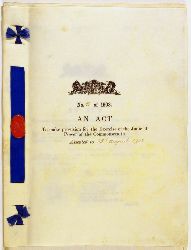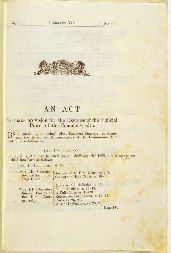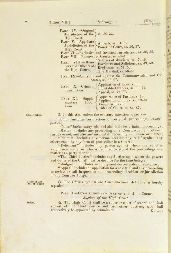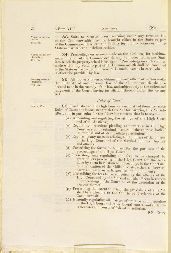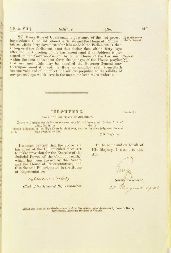

Judiciary Act 1903 (Cth)
Significance
This document founded the High Court of Australia as provided for in Chapter 3 of the Australian Constitution Act 1900.The High Court has authority to decide matters relating to the Australian Constitution and in exercising this power has itself influenced the constitutional development of the States and of the Commonwealth. The enactment of the Judiciary Act established the High Court as Australia's ultimate court, where appeals from State Supreme Courts could be taken.
History
The aim in drafting Chapter 3 of the Australian Constitution was to establish a supreme federal court not so much to deal with constitutional interpretation, but to provide a final court of appeal in Australia and abolish appeals to the Privy Council on Australian matters. This aim was stalled by the British Parliament's amendment of the Constitution Bill so that appeals against decisions of the State Supreme Courts and of the High Court could be heard by the Judicial Committee of the Privy Council. Under this compromise, an appeal could go from a State Supreme Court to the High Court and, if the appellant wished, from there to the Privy Council, or an appeal could go from a Supreme Court direct to the Privy Council. A 1907 amendment to the Judiciary Act prevented constitutional cases taking the 'side door' route from a State to the Privy Council, and ensured the High Court would make the final decision in interpreting the Australian Constitution.The Judiciary Bill passed through the second session of the Commonwealth Parliament in the winter of 1903, and was enacted on 25 August that year. On 5 October 1903, the Governor-General approved the appointment of Samuel Griffith, Edmund Barton and Richard O'Connor as the first judges and the first sitting of the High Court took place the following day, in the Supreme Court building in Melbourne. The number of judges was increased to five in 1906, with the appointments of Isaac Isaacs and Henry Bourne Higgins; and to seven in 1913 when Frank Gavan Duffy and Charles Powers were appointed. The Court transferred from its Sydney and Melbourne premises to Canberra when the new High Court building was completed there in 1980.
The High Court has authority to decide matters relating to the Australian Constitution and in exercising this power has itself influenced the constitutional development of the states and of the Commonwealth. Notable cases in which the High Court has exercised the power of interpreting the Constitution include the Engineers Case in 1920, the Uniform Tax Case in 1942, the Koowarta Case in 1982, the Franklin Dam Case in 1983, the Mabo Case in 1992 and the Toonan Case in 1994.
In the Engineers Case, the Court held that rulings of the Commonwealth Conciliation and Arbitration Court were binding on State governments. The authority of this Court's decisions had been a subject of debate since it was established in 1904, as its rulings in industrial matters exhibited the tension between 'multiple' and 'central' modes of federation. The decision in the Engineers Case was a move towards more centralised authority.
The Uniform Tax Case in 1942 decided a challenge to legislation passed by the Curtin Labor Government to give the Commonwealth the exclusive right to income tax revenue as a wartime measure. The Court again maintained the 'centralist' principle, although with the dissent of the Chief Justice, Sir John Latham, and of Justice Starke. This extension of Federal power persisted, as the States did not recover the right to collect income tax after the war ended in 1945.
The Uniform Tax Case was seen as 'the high water mark of Engineers principles' until the Koowarta Case and the Franklin Dam Case 40 years later. In 1982 the High Court upheld the right of a Wik man, John Koowarta, to buy land in north Queensland and ruled the Queensland government policy of disallowing Aboriginal people from owning land was in conflict with the Commonwealth Racial Discrimination Act. The following year, the High Court upheld Commonwealth world heritage legislation which prevented the construction of a dam for the production of hydro-electricity, reasoning that the Commonwealth could make laws necessary to implement international agreements made under the external affairs power granted by Section 51 of the Constitution. The same principles were upheld in the High Court's ruling to hear the Toonen Case in 1994, involving the superior authority of Commonwealth legislation implementing the United Nations Charter of Human Rights over Tasmanian anti-homosexuality laws.
The Mabo Case 1992 was similar to Koowarta in that Indigenous people brought a case to the High Court after the Queensland government had refused to register ownership of land.
Sources
Zines, Leslie, The High Court and the Constitution, Butterworths, Sydney, 1997.
Description
This document is in the form of a booklet secured with three blue silk ribbons on which there is an oval red seal, featuring a Crown and the words 'Parliament of the Commonwealth'. There are corrections on pages 5 and 9, and another for the printer on page 19. 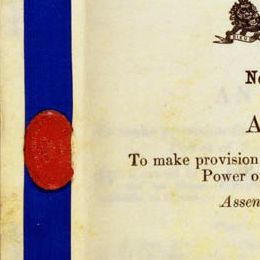
Detail of the cover of the Judiciary Act 1903 (Cth), showing the wax seal.
| Long Title: | An Act to make provision for the Exercise of the Judicial Power of the Commonwealth. (No. 6 of 1903) |
| No. of pages: | 24 + cover (last three pages blank) |
| Medium: | Parchment cover, untrimmed paper pages |
| Measurements: | 28.8 x 22.3 cm |
| Provenance: | House of Representatives |
| Features: | This document differs from the earlier Acts as the red wax seal is oval, rather than round |
| Location & Copyright: | National Archives of Australia |
| Reference: | NAA: A1559/1, 1903/6 |
